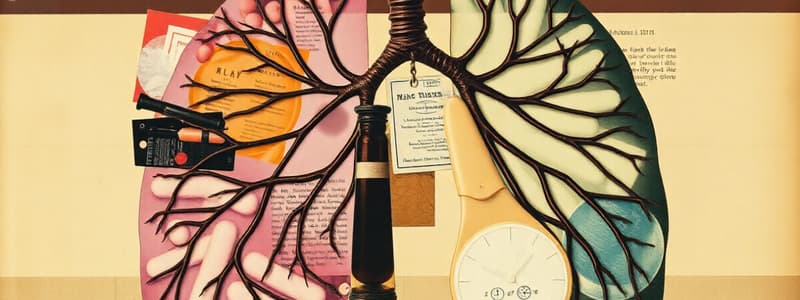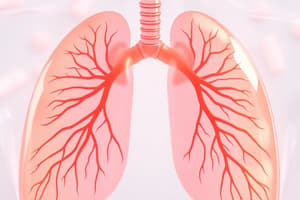Podcast
Questions and Answers
Which of the following best describes the focus of respiratory care pharmacology?
Which of the following best describes the focus of respiratory care pharmacology?
- The preparation and dispensing of medications used in all areas of healthcare.
- The identification of natural sources, such as plants and minerals, for new drug development.
- The application of pharmacology specifically to cardiopulmonary diseases and critical care. (correct)
- The study of the genetic factors influencing drug responses in diverse populations.
A respiratory therapist is administering a drug with the generic name 'albuterol'. What is the therapist administering?
A respiratory therapist is administering a drug with the generic name 'albuterol'. What is the therapist administering?
- The nonproprietary name that is adopted by a standards body and can be manufactured by multiple companies. (correct)
- The drug's official chemical identification, as determined by the IUPAC nomenclature.
- The drug's code name used during research and development phases.
- The manufacturer's exclusive trade name for marketing the drug.
During the drug approval process in the United States, a pharmaceutical company has completed Phase III clinical trials. What is the primary purpose of Phase III?
During the drug approval process in the United States, a pharmaceutical company has completed Phase III clinical trials. What is the primary purpose of Phase III?
- To evaluate the drug's effectiveness and monitor for adverse reactions in a large patient group. (correct)
- To conduct initial safety assessments on a small group of healthy volunteers.
- To isolate and identify the chemical compound with potential therapeutic effects.
- To determine the drug's bioavailability and pharmacokinetic properties in animal subjects.
A physician writes a prescription for a patient with the abbreviation 'Sig' followed by instructions. Which part of the prescription is 'Sig'?
A physician writes a prescription for a patient with the abbreviation 'Sig' followed by instructions. Which part of the prescription is 'Sig'?
A researcher is studying how genetic variations influence an individual's response to bronchodilators. Which field of study is this researcher engaged in?
A researcher is studying how genetic variations influence an individual's response to bronchodilators. Which field of study is this researcher engaged in?
A doctor prescribes a medication with the abbreviation 'qod'. What instructions should the patient follow?
A doctor prescribes a medication with the abbreviation 'qod'. What instructions should the patient follow?
Which route of drug administration is indicated by the abbreviation 'IM'?
Which route of drug administration is indicated by the abbreviation 'IM'?
What is the primary effect of $\beta$-Adrenergic agents on bronchial smooth muscle?
What is the primary effect of $\beta$-Adrenergic agents on bronchial smooth muscle?
A patient has significant upper airway swelling. Which type of adrenergic agent would be most appropriate to administer?
A patient has significant upper airway swelling. Which type of adrenergic agent would be most appropriate to administer?
What is a key advantage of delivering respiratory medications via aerosolization compared to systemic administration?
What is a key advantage of delivering respiratory medications via aerosolization compared to systemic administration?
Why are aerosolized drugs considered relatively safe and convenient?
Why are aerosolized drugs considered relatively safe and convenient?
A prescription is filled with a generic version of the prescribed drug. What does this indicate?
A prescription is filled with a generic version of the prescribed drug. What does this indicate?
When a prescription indicates 'prn', how should the medication be administered?
When a prescription indicates 'prn', how should the medication be administered?
A patient with asthma is experiencing bronchoconstriction induced by cholinergic activity. Which class of medications would be MOST appropriate to improve ventilatory flow rates?
A patient with asthma is experiencing bronchoconstriction induced by cholinergic activity. Which class of medications would be MOST appropriate to improve ventilatory flow rates?
A cystic fibrosis patient has a persistent Pseudomonas Aeruginosa infection. Which anti-infective agent would be MOST appropriate for treatment?
A cystic fibrosis patient has a persistent Pseudomonas Aeruginosa infection. Which anti-infective agent would be MOST appropriate for treatment?
Which of the following medications is designed to directly modify the properties of respiratory tract mucus to promote clearance of secretions?
Which of the following medications is designed to directly modify the properties of respiratory tract mucus to promote clearance of secretions?
A newborn is diagnosed with Respiratory Distress Syndrome (RDS). Which route of administration is MOST appropriate for administering an exogenous surfactant?
A newborn is diagnosed with Respiratory Distress Syndrome (RDS). Which route of administration is MOST appropriate for administering an exogenous surfactant?
Which of the following best describes the primary mechanism of action for antiasthmatic agents?
Which of the following best describes the primary mechanism of action for antiasthmatic agents?
A patient is diagnosed with pulmonary hypertension. Which class of medication is MOST likely to be prescribed to decrease shortness of breath and increase walking distance?
A patient is diagnosed with pulmonary hypertension. Which class of medication is MOST likely to be prescribed to decrease shortness of breath and increase walking distance?
A patient has been prescribed Dornase Alfa. What is the expected therapeutic effect of this medication?
A patient has been prescribed Dornase Alfa. What is the expected therapeutic effect of this medication?
Which medication is specifically used to treat Pneumocystis jiroveci pneumonia (PCP)?
Which medication is specifically used to treat Pneumocystis jiroveci pneumonia (PCP)?
Flashcards
Drugs
Drugs
Any chemical that alters an organism's functions or processes.
Pharmacology
Pharmacology
The study of drugs, including origins, properties and interactions with living organisms.
Respiratory Care Pharmacology
Respiratory Care Pharmacology
Application of pharmacology to cardiopulmonary disease and critical care.
Therapeutics
Therapeutics
Signup and view all the flashcards
Toxicology
Toxicology
Signup and view all the flashcards
Over-the-counter drugs
Over-the-counter drugs
Signup and view all the flashcards
Generic substitution
Generic substitution
Signup and view all the flashcards
q
q
Signup and view all the flashcards
qh
qh
Signup and view all the flashcards
prn
prn
Signup and view all the flashcards
Aerosolized agent advantages
Aerosolized agent advantages
Signup and view all the flashcards
β-Adrenergic action
β-Adrenergic action
Signup and view all the flashcards
α-Adrenergic action
α-Adrenergic action
Signup and view all the flashcards
Anticholinergic Agents
Anticholinergic Agents
Signup and view all the flashcards
Mucoactive Agents
Mucoactive Agents
Signup and view all the flashcards
Antiasthmatic Agents
Antiasthmatic Agents
Signup and view all the flashcards
Anti-infective Agents
Anti-infective Agents
Signup and view all the flashcards
Exogenous Surfactants
Exogenous Surfactants
Signup and view all the flashcards
Prostacyclin Analogs
Prostacyclin Analogs
Signup and view all the flashcards
Anti-Infective
Anti-Infective
Signup and view all the flashcards
Mucoactive
Mucoactive
Signup and view all the flashcards
Study Notes
- Study notes for Rau's Chapter 1: Introduction to Respiratory Care Pharmacology
Pharmacology and the Study of Drugs
- Drugs are chemicals altering an organism's functions or processes.
- Pharmacology is the study of drugs, including their origins, properties, and interactions with living organisms.
- Respiratory Care Pharmacology is applying pharmacology to cardiopulmonary disease and critical care.
- Pharmacy involves preparing and dispensing drugs.
- Pharmacognosy is the identification of sources of drugs.
- Pharmacogenetics studies the interrelationship of genetic differences and their effects.
- Therapeutics is the art of treating disease with drugs.
- Toxicology studies toxic substances and their pharmacologic actions.
Naming Drugs
- Drugs have various names, including chemical, code, generic, official, and trade names.
Sources of Drugs
- Drugs can be derived from animal sources like thyroid hormone, insulin, and pancreatic dornase.
- Plant sources include khellin, atropine, digitalis, reserpine, eucalyptus oil, pine oil, and anise.
- Mineral sources include copper sulfate, magnesium sulfate, and mineral oil.
Process of Drug Approval in the United States
- The approval process includes chemical isolation and identification, animal studies, and investigational new drug approval.
- Investigational New Drug approval has phases I, II, and III.
- The process also requires a New Drug Application and considerations for Food and Drug Administration drug classification and if needed, Orphan drugs.
The Prescription
- Prescriptions consist of parts such as the patient's name, address, and date; the Rx symbol; inscription; subscription; Sig; and the prescriber's name.
- Over-the-counter drugs do not require a prescription.
- Generic substitution in prescriptions allows for any manufacturer's version of the prescribed drug, which is generally less expensive.
Abbreviations used in Prescriptions
- Common abbreviations used in prescriptions include:
- q (every)
- qh (every hour)
- qid (four times daily)
- qod (every other day)
- qd (every day)
- q2h (every 2 hours)
- q3h (every 3 hours)
- q4h (every 4 hours)
- po (per os, by mouth)
- prn (as needed)
- IM (intramuscular)
- IV (intravenous)
- tid (three times daily)
- See Table1.3
Respiratory Care Pharmacology: An Overview
- Aerosolized agents are given via inhalation.
- They have five advantages.
- Related drug groups in respiratory care include:
- Anti-infective agents
- Neuromuscular blocking agents
- Central nervous system agents
- Antiarrhythmic agents
- Antihypertensive and antianginal agents
- Anticoagulant and thrombolytic agents
- Diuretics
Advantages of Aerosolized Agents Given by Inhalation
- Aerosol doses are smaller than systemic doses for the same purpose.
- Aerosol delivery usually results in fewer and less severe side effects compared to oral or parenteral delivery.
- The onset of action is rapid.
- Drug delivery is targeted to the respiratory system, resulting in lower systemic bioavailability.
- The inhalation of aerosol drugs is painless, relatively safe, and can be convenient, depending on the delivery device.
Adrenergic Agents
- Beta-Adrenergic agents relax bronchial smooth muscle and cause bronchodilation.
- These reduce airway resistance (Raw) and improve ventilatory flow rates in airway obstruction.
- Obstruction results from chronic obstructive pulmonary disease (COPD), asthma, cystic fibrosis (CF), or acute bronchitis.
- Examples include Albuterol, Arformoterol, Formoterol, Levalbuterol, and Salmeterol.
- Alpha-Adrenergic agents cause topical vasoconstriction and decongestion.
- They're used to treat upper airway swelling.
- An Example is Racemic Epinephrine.
Anticholinergic Agents
- These agents relax cholinergically induced bronchoconstriction.
- Which improves ventilatory flow rates in COPD and asthma
- Examples include Glycopyrrolate bromide, Ipratropium Bromide, and Tiotropium Bromide.
Mucoactive Agents
- These agents modify the properties of respiratory tract mucus.
- Current version reduces viscosity and promote clearance of secretions.
- Examples include Acetylcysteine, Dornase Alfa, Mannitol, and Hyperosmolar Saline.
- Current version reduces viscosity and promote clearance of secretions.
Antiasthmatic Agents
- These agents prevent the onset and development of the asthmatic response.
- Through inhabitation of chemical mediators of inflammation
- Some examples include Cromolyn Sodium, Montelukast, and Omalizumab.
Anti-infective Agents
- These agents inhibit or eradicate specific infective agents.
- Examples include *Ribavirin for the treatment of RSV
- *Pentamidine for the treatment of Pneumocystic Jiroveci Carinii (PCP)
- *TOBI for the treatment of Pseudomonas Aeruginosa, particularly in CF or Influenza A and B.
Exogenous Surfactants
- Their approved clinical use is by direct intratracheal instillation.
- Restores more normal lung compliance in RDS of newborns
- Examples include Beractant, Calfactant, Poractant Alfa, and Lucinactant.
Prostacyclin Analogs
- Are clinically indicated to treat pulmonary hypertension.
- Specifically to decrease shortness of breath and increase walking distance
- Examples include Iloprost and Treprostinil.
Studying That Suits You
Use AI to generate personalized quizzes and flashcards to suit your learning preferences.
Related Documents
Description
Study notes covering Chapter 1's introduction to respiratory care pharmacology. Key topics include the definition of drugs, pharmacology, drug naming conventions, and sources of drugs. The notes also cover pharmacognosy, pharmacogenetics, therapeutics and toxicology.




